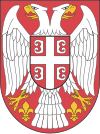Tourism in Serbia
| Economy of Serbia |
|---|
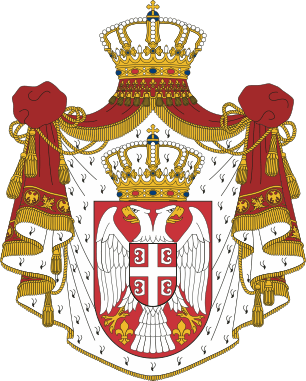 |
| Overview |
| Sectors |
| Serbia topics |
|

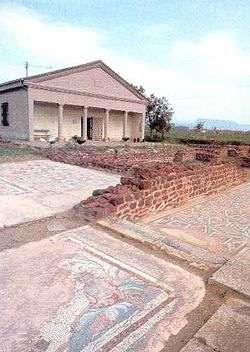
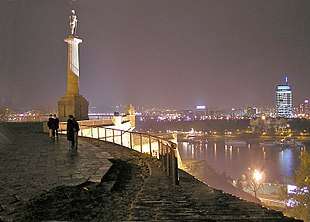
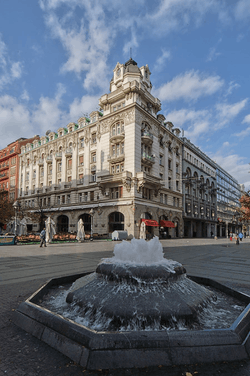
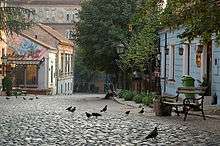
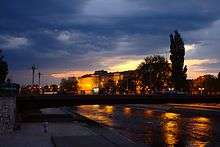

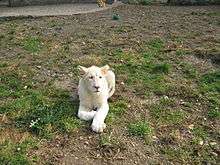
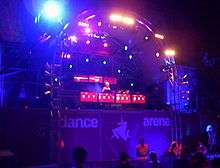
Tourism in Serbia is officially recognised as a primary area for economic and social growth.[1] The hotel and catering sector accounted for approximately 1.0% of GDP in 2010.[1] Tourism in Serbia employs some 75,000 people, about 3% of the country's workforce.[1] In recent years the number of tourists is increasing, especially foreign once for about hundred thousand arrivals more each year. Major destination of foreign tourists is Belgrade and, to a lesser degree, Novi Sad, while domestic tourists prefer spas and mountain resorts.[2]
Gallery
 Manasija monastery.
Manasija monastery.- Ravanica monastery.
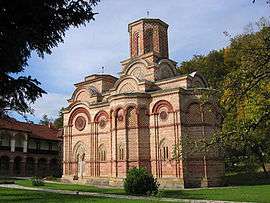 Kalenić monastery.
Kalenić monastery. Gračanica monastery.
Gračanica monastery.
History and statistics
In the 1980s Yugoslavia was an important tourist destination in the Balkans. Overnight stays were almost 12 million per year, of which about 1.5 million were by foreign tourists. The events surrounding the break-up of Yugoslavia led to a substantial decline in both leisure and business tourism.[3]
In the twenty-first century tourism began to recover: the number of overseas visitors was 90% higher in 2004 than it had been in 2000, and revenue from foreign tourism more than tripled between 2002 and 2004, to about 220 million US dollars.[3] By 2010 revenue from international tourism had grown to 798 million while in 2016 it was estimated at 1.151 Billion.[4]
Arrivals per year
| Year | Arrivals | Domestic | Foreign |
|---|---|---|---|
| 2003[5] | 1,997,947 | 1,658,664 | 339,283 |
| 2004[6] | 1,971,683 | 1,579,857 | 391,826 |
| 2005[7] | 1,988,469 | 1,535,790 | 452,679 |
| 2006[8] | 2,006,488 | 1,537,646 | 468,842 |
| 2007[9] | 2,306,558 | 1,610,513 | 696,045 |
| 2008[10] | 2,266,166 | 1,619,672 | 646,494 |
| 2009[11] | 2,021,166 | 1,375,865 | 645,301 |
| 2010 | 2,000,597 | 1,317,916 | 682,681 |
| 2011 | 2,068,610 | 1,304,443 | 764,167 |
| 2012 | 2,079,643 | 1,269,676 | 809,967 |
| 2013 | 2,192,435 | 1,270,667 | 921,768 |
| 2014[12] | 2,194,268 | 1,165,536 | 1,028,732 |
| 2015[13] | 2,437,165 | 1,304,944 | 1,132,221 |
| 2016[14] | 2,753,591 | 1,472,165 | 1,281,426 |
| 2017 [15] | 3,085,866 | 1,588,693 | 1,497,173 |
| 2018[16] | 2,359,446 | 1,207,262 | 1,152,184 |
Arrivals by country
| 2018[16] | 2017[15] | |||
|---|---|---|---|---|
| # | Country | Arrivals | Country | Arrivals |
| 1 | 77,424 | 108,058 | ||
| 2 | 77,379 | 99,500 | ||
| 3 | 64,991 | 91,233 | ||
| 4 | 62,720 | 83,499 | ||
| 5 | 61,319 | 79,326 | ||
| 6 | 54,939 | 78,486 | ||
| 7 | 53,658 | 78,211 | ||
| 8 | 53,426 | 67,395 | ||
| 9 | 53,323 | 66,747 | ||
| 10 | 43,480 | 60,564 | ||
| 11 | 41,872 | 51,691 | ||
| 12 | 41,772 | 49,857 | ||
| 13 | 35,205 | 49,533 | ||
| 14 | 34,343 | 45,309 | ||
| 15 | 30,584 | 40,942 | ||
| Total international visitors | 1,152,184 | Total international visitors | 1,497,173 |
See also
References
- 1 2 3 Serbia Archived 2016-03-03 at the Wayback Machine., in: Alain Dupeyras (ed.) (2012). OECD tourism trends and policies 2012. Paris: Organization for Economic Cooperation & Development. ISBN 9789264177567. p. 403–407.doi:10.1787/tour-2012-56-en
- ↑ "Туризам и угоститељство (Tourism and catering trade)" (PDF). 2017-10-19. Archived (PDF) from the original on 2017-10-24. Retrieved 2017-12-10.
- 1 2 Marat Terterov (ed.) (2006). Doing business with Serbia Archived 2016-02-05 at the Wayback Machine., second edition. London: GMB Publishing. ISBN 978-1-905050-14-7. p.177.
- ↑ http://www.e-unwto.org/doi/pdf/10.18111/9789284419029 UNWTO report
- ↑ "2003 статистика". srbija.travel. Archived from the original on 2014-08-13. Retrieved 2017-12-10.
- ↑ "2004 стастика". srbija.travel. Archived from the original on 2015-12-22. Retrieved 2017-12-10.
- ↑ "2005 статистика". srbija.travel. Archived from the original on 2015-12-22. Retrieved 2017-12-10.
- ↑ "2006 статистика". srbija.travel. Archived from the original on 2014-01-09. Retrieved 2017-12-10.
- ↑ "2007 статистика". srbija.travel. Archived from the original on 2015-12-22. Retrieved 2017-12-10.
- ↑ "2008 статистика". srbija.travel. Archived from the original on 2015-12-22. Retrieved 2017-12-10.
- ↑ "2009-2013 статистика" (PDF). srbija.travel. Archived from the original (PDF) on 17 July 2014. Retrieved 26 April 2018.
- ↑ "2014 статистика" (PDF). srbija.travel. Archived from the original (PDF) on 15 September 2015. Retrieved 26 April 2018.
- ↑ "Републички завод за статистику – Statistical Yearbook of the Republic of Serbia – Tourism, 2015" (PDF). 2015-10-05. Archived (PDF) from the original on 2017-03-29. Retrieved 2017-12-10.
- ↑ "Туристички промет - децембар 2016 (2016 statistics)" (PDF). 2017-01-26. ISSN 0353-9555. Archived (PDF) from the original on 2017-04-03. Retrieved 2017-12-10.
- 1 2 "Туристички промет - децембар 2017. (2017 statistics)" (PDF). 2017-12-29. ISSN 0353-9555. Archived (PDF) from the original on 2018-01-31. Retrieved 2017-12-29.
- 1 2 "Statistical Office of the Republic of Serbia, data for first 8 months of 2018" (PDF). Archived (PDF) from the original on 2018-04-04.
Further reading
- Ana Nikolov (29 July 2005). "Beograd – grad na rekama". Institut za Arhitekturu i Urbanizam Srbije. Retrieved 2007-06-05.
- "Zbogom, oazo!" (in Serbian). Kurir. 23 May 2006. Retrieved 2007-06-05.
- Beoinfo (4 August 2005). "Prirodno dobro "Veliko ratno ostrvo" stavljeno pod zaštitu Skupštine grada" (in Serbian). Ekoforum. Archived from the original on 26 July 2011. Retrieved 2007-06-05.
- Eve-Ann Prentice (10 August 2003). "Why I love battereBelgrade". The Guardian Travel. London. Archived from the original on 15 May 2007. Retrieved 2007-05-19.
- Seth Sherwood (16 October 2005). "Belgrade Rocks". The New York Times. Retrieved 2007-05-19.
- Barbara Gruber (22 August 2006). "Belgrade's Nightlife Floats on the Danube". Deutsche Welle. Retrieved 2007-05-19.
- "Slovenci dolaze u jeftin provod" (in Serbian). Glas Javnosti. 21 December 2004. Retrieved 2007-07-10.
- "U Beograd na vikend-zabavu" (in Croatian). Večernji list. 6 January 2006. Archived from the original on 2006-01-06. Retrieved 2007-06-15.
- Gordy, Eric D. (1999). "The Destruction of Musical Alternatives". The Culture of Power in Serbia: Nationalism and the Destruction of Alternatives. Penn State Press. pp. 121–122. ISBN 0-271-01958-1. Retrieved 2007-07-10.
- "Intro". Club "Akademija". Retrieved 2007-07-10.
- "Klub Studenata Tehnike - O nama" (in Serbian).
- "Beogradska Industrija Piva AD". SEE News. Archived from the original on 2009-04-26. Retrieved 2009-05-05.
- Dulovic, Vladimir (1 February 2013). "The Oldest Houses In Belgrade". Livinginbelgrade.com.
- "Znamenite građevine 3" (in Serbian). Official site. Retrieved 2007-07-10.
- Scurlock, Gareth (4 November 2008). "Europe's best nightlife". London: Official site. Retrieved 2008-04-11.
- "The world's top 10 party towns". The Sydney Morning Herald. 9 November 2009. Retrieved 2010-03-16.
- "Exit Festival Official Websiyr". Archived from the original on 2012-02-10.
External links
| Wikivoyage has a travel guide for Serbia. |
- National Tourism Organization of Serbia

